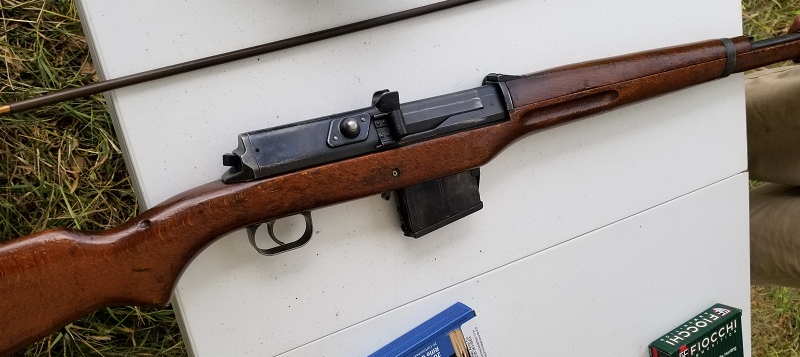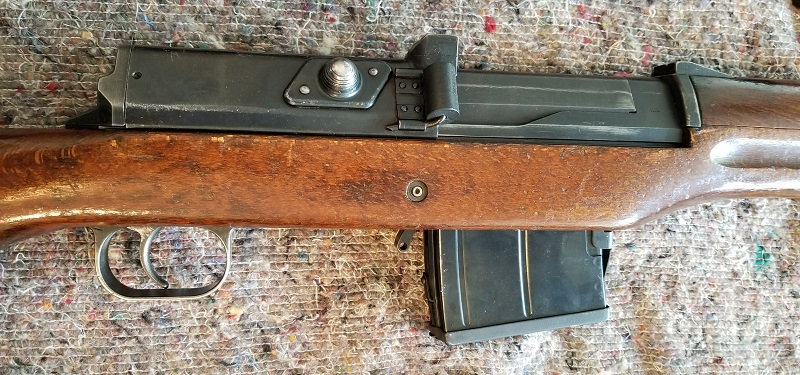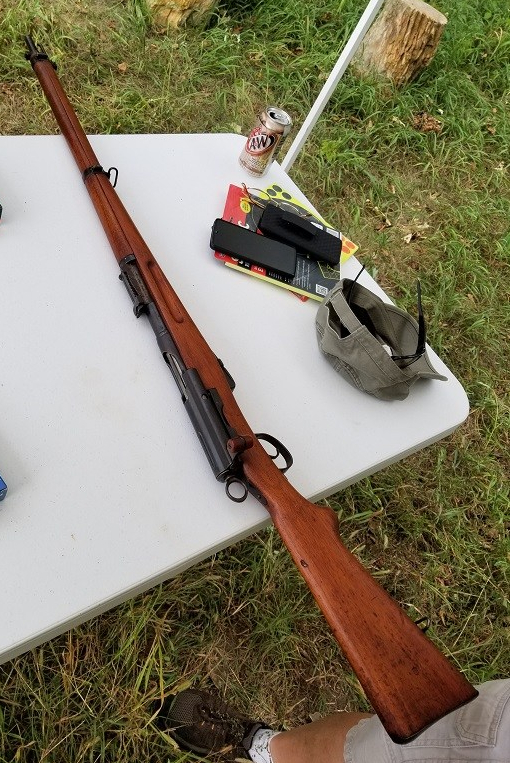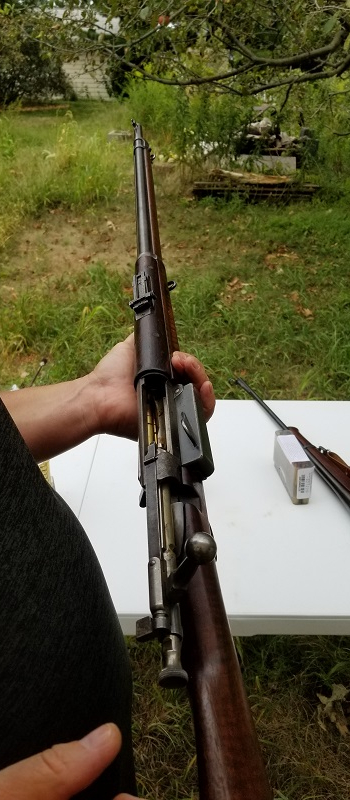The Fightin’ Swedes/Swiss.
Two last battle rifles today: the Swedish Ag m/42B in 6.5×55 and the Swiss Schmidt-Rubin Model 1911 rifle.

Swedish Automatgevär m/42
We should have done our homework on this.
Why? Because we had no idea about how to operate it. I’ll save you the several videos of us fumbling with it, trying to figure out what the hell made the thing work. Instead, go watch this video of how the mechanism works, if you’re interested.
At least none of us mashed our thumbs, which even Ian at Forgotten Weapons was nervous about (watch his second video there).
Anyway, the Swedish AG m/42B is a direct gas-impingement self-loading rifle introduced in 1942. It’s a little odd in design, but makes sense once you understand it (which I really didn’t until I did research for this post). And it’s fairly simple and robust, so was able to stay in use until the 1960s. Here are a couple of additional images of it:

Swedish Automatgevär m/42B

Swedish Automatgevär m/42B
Those odd knob things? That’s the dust cover/bolt carrier, and it’s how you operate the loading mechanism safely. Go watch the video above — trying to explain it is … complicated.
Note the simple range adjustment dial for the sight there on the left (bottom) in front of the receiver. Nice, easy to use. Because that’s one of the great things about this rifle — the 6.5×55 Swedish cartridge is a very flat-shooting round, and the rifle has an effective range out to 800 meters. The rifle is also relatively heavy, so that combined with a simple integrated muzzle break means that it has very light recoil. See for yourself:
This was really a pleasure to shoot, and while I’m not into rifles that much, I could easily see myself having one of these guns.
Schmidt-Rubin Model 1911 rifle

Model 1911
The Schmidt-Rubin was a heavy battle rifle, designed for the long tradition of Swiss sharpshooting. As part of a series of rifles beginning with the Model 1889, the Model 1911 entered service in 1911 (surprise!). Firing a new more powerful cartridge (7.5×55) than the previous models, it had an aimed range out to 600 meters, and a volley range to 2000 meters. It has a straight-pull bolt action (no need to rotate the bolt to unlock it) which is slick and fast.

Schmidt-Rubin Model 1911
It’s easy to operate, easy to shoot well. It was also famously accurate, and is still valued as both a hunting and long distance target rifle. With a 175gr bullet at 2650fps out of the long 30″ barrel generating about 2700ft/lbs of energy, it is perfectly suitable for either. Since the Model 1911 weighs about ten pounds, recoil is modest.
As I’ve said several times with these historic rifle reviews, if you get a chance to shoot either the Swiss Schmidt-Rubin or the Swedish Ag m/42B, do so.
But if it’s the Ag? Watch your thumbs.
Jim Downey
Two Classic Battle Rifles.
You can probably guess which ones I mean. Yeah, that’s how big of an impact they had on history.
The M1903 Springfield and the Lee-Enfield (specifically, the SMLE No.1 Mk III). Both bolt-action guns (actually, both derived from the G98 Mauser design). Both shooting powerful .30 caliber cartridges with an effective aimed range in excess of 500 yards. And both having played an important role in World War I and World War II.
Of course, there are some real differences between these cousins. Let’s talk about that after a brief look at each one:
The M1903 Springfield was the successor to the Krag-Jørgensen rifle, bringing greater power and rate of fire into the hands of US soldiers than the earlier rifle offered. The .30-06 cartridge was “high power”: a 150gr bullet at almost 3,000fps, for about 2,800ft/lbs of energy. Which was about 50% more power and a better ballistic coefficient than the Krag had, and that translated into a greater effective fighting range.

M1903 Springfield
The M1903 held 5 rounds, inserted via stripper clips for speed. The Mauser style bolt handle was lower on the gun, again for speed. It was slick, solid, and accurate. Here it is in operation last weekend:
One particular thing I want to note: the difficulty that he has with the sight is common, and it’s something that hickock45 comments on at about 1:30 in his video review of it.
The M1903 Springfield entered service in 1903 (hence the designation), was the primary battle rifle in WWI, played a major role in WWII, and continued to be used as a sniper rifle (and in some other applications) through into even the Vietnam War.
The Lee-Enfield was the successor to the Martini-Henry (and variants) in the British army, coming into use in the mid 1890s. The new smokeless version of .303 British cartridge had ballistics very similar to the US .30-06, but was slightly shorter overall. This, combined with a short throw on the bolt-action, allowed for a very rapid rate of aimed fire by a trained rifleman of up to 35 rounds per minute. The magazine of the SMLE held 10 rounds, fed by 5-round ‘chargers’ similar to the stripper-clips used in the M1903. Like the Krag, the Lee-Enfield had a magazine cut-off which would allow it to function purely as a single-shot.

Lee-Enfield SMLE No. 1 Mk III
We didn’t try to manipulate the bolt-action for rapid fire, but this was a common tactic in the British forces, and they could routinely fire up to 35 rounds per minute while keeping the rifle shouldered for aimed fire. This kind of sustained rate of fire made the Lee-Enfield a formidable weapon which remained in use in subsequent variants through the Korean War.
So, what were the differences between these two classic battle rifles?
Well, range and rate of fire, for the most part. The M1903 Springfield had a greater range with excellent accuracy, enough to be used as a sniper rifle through WWII and Korea. The .30-06 cartridge is so good for this sort of use that it is still a common long range hunting cartridge for medium sized game and target shooting to this day.
But the M1903 couldn’t compete with the Lee-Enfield for rate of fire, particularly while still shouldered. The Australians, using the Lee-Enfield, even developed a technique which allowed up to 55 rounds per minute:
The tactic was to fire in conventional rapid-fire mode until the enemy was approximately 100 to 150 yds. away. Then the right hand would leave the small of the butt, and the thumb and first finger would grasp the bolt handle. The little or lower finger was then used to fire the rifle, and the bolt cycled using those two fingers, which stayed on the bolt handle until the rifle was empty. As soon as the bolt handle was down, the trigger was then pulled and the cycle recommenced. As the targets appeared, a quick snap shot was made. The bolt was already working and the recoil was utilized with the disturbance in moving the bolt to align on the next target which was again snap shot. Attention was given to the target only until the shot was made.
Wild. I’d love to see someone actually able to do that, with some degree of accuracy.
Anyway, both the M1903 Springfield and the Lee-Enfield rifles are fairly common today. But as it happens, I don’t think that I had ever gotten around to shooting a SMLE until this outing. And I’ve been shooting for 50+ years. Don’t make the same mistake if you can avoid it.
Jim Downey
1898 Krag-Jørgensen Rifle
Man, I’m happy that I took a lot of images last weekend when we shot these rifles.
OK, as I’ve noted, I’m not really a “rifle guy”. And especially not a “historic rifle guy”. Oh, I can generally ID most of the major designs in history, but damned if I would be able to identify the dozens of minor variations and such.
Which is why I’m writing these blog posts: I’m learning a lot. And like I said, I’m glad that I took a lot of images, because it’s allowed me to determine specific details key to figuring out what a given gun actually is. Like the “1898” stamped on the side of the receiver of this Krag-Jørgensen Rifle:

Krag-Jørgensen Rifle
Nah, you probably can’t see it at the resolution I’ve posted here, but I could make out the date there on the left side of the receiver, under and to the left of the “U.S.” stamp.
The Krag was an important piece of history, both in terms of the technology it introduced, and in the role it played as a military arm. It had an innovative magazine design (more on that in a moment), and fired the first metalic cartridge completely designed to make use of the new smokeless powder: the .30-40 Krag. This was a .30 caliber, 220gr bullet that would achieve 2,000fps out of this rifle, for a respectable 1950ft/lbs of energy. The Krag-Jørgensen was well designed overall, and to this day is considered to be one of the smoothest operating bolt-action guns ever.
Now, about that interesting magazine. Take a look here, with the bolt open:

Krag-Jørgensen Rifle
See how the cartridge is tucked off to the left side there? The magazine cover on the outside of the right side of the gun flips open. Then you just drop up to 5 cartridges onto the shelf and close the cover. When you do, they’re all arranged horizontally. Yeah, weird. But it’s kinda cool, because it is fast and easy to load, and you can top off your magazine at any time. You’ll be able to see this even better in the video below.
But before we get to that, I want to mention something else about the design. There’s a “magazine cut-off switch” on the left side of the receiver, which prevents a cartridge from loading from the receiver. Instead, you could just drop a round in front of the bolt face, and chamber it. This reflected the mind-set of the era, when accurate aimed fire was considered more important than rate of fire. Again, you can see this even better in the video:
As noted in the video, this is an exceptionally smooth operating and accurate rifle, especially considering that it is over 120 years old. It feels very well balanced and easy to use in your hands, in part due to the extra mass of metal in the magazine design. It really was a pleasure to shoot. If you ever get a chance to do so, don’t miss it. As hickock45 notes in this video, they’re not terribly common, so be sure to take advantage of the opportunity.
Jim Downey
4 Nice Reproduction Rifles
As part of our historical rifle weekend, we shot 4 different reproduction rifles all dating to the latter part of the 19th century. In rough chronological order, these were the Spencer Repeating Rifle, the Remington Rolling Block Rifle, the Springfield Model 1873, and the Winchester Model 1885 (High Wall version). Here are our four reproductions:

Four reproductions.
From left to right in the image:
- Winchester Model 1885 (High Wall version) Reproduction by Browning.
- Springfield Model 1873 (‘Trapdoor’ Springfield) Reproduction by Pedersoli.
- Remington Rolling Block Rifle Reproduction by Remington.
- Spencer Repeating Rifle Reproduction by Chiappa.
All shoot the .45-70 cartridge, except for the Spencer, which is in .45 Colt. All are like brand new, having been fired little, even though they were a few years old. Full info is readily available about each original design, as well as about these reproductions, so I’m just going to share some thoughts and video on each one without going into a huge amount of detail.
This nice little reproduction by Chiappa is a very handy and fun gun.

Spencer carbine
The quality of the gun overall is quite nice, with good wood and a very attractive case-hardened receiver. The lever-operated loading mechanism was smooth, but both the trigger and the extractor were in need of breaking in, as can be seen in this video:
This gun holds seven rounds of .45 Colt in the tube magazine located in the stock (the same number as the original in .56-56 Spencer, which has similar ballistics to the modern cartridge). We were only shooting at 25 yards, but this was an easy gun to use quickly, and I can see how it would have been a revolutionary improvement over the muzzle-loaders of the era.
The Remington Rolling Block No. 1 Sporter was a very fine gun, exceptionally well made with excellent fit and finish in every regard:

Remington Rolling Block
The rolling block mechanism was solid, and gave confidence that it would hold up to plenty of use shooting full-power .45-70 loads. Likewise, the substantial weight of the gun meant that recoil was manageable. This is a gun I could easily spend a day with at the range.

Ah, yes, the Trapdoor Springfield. There’s something that’s just plain cool about this gun.

Pedersoli Trapdoor
Of course, Pedersoli is well-known for the quality of their reproductions, and this is no exception. The entire mechanism of the breechblock was tightly fitted and solid, operating smoothly. Likewise the trigger was smooth and comfortable. As with the Remington above, the gun had enough mass to tame recoil from the .45-70 gov loads we were shooting, and it was easy to be accurate with it even on first try.
This is the so-called “High Wall” version, designed to handle high power loads, such as the .45-70 gov cartridge. This reproduction is by Browning, and this particular gun had been custom etched (with inlay) with a “Right to Keep and Bear Arms” design:

Browning 1885
The review of this gun linked above is picky about a number of things which didn’t bother me. I’m not sure whether that is due to our having a slightly different model, or what. I thought that the fit & finish were fine, and the gun operated flawlessly as far as I could tell. I didn’t note any excessive recoil at the time of shooting, though I’m not particularly recoil-shy, so I was surprised to see that in the review. Perhaps if we had tried some more powerful loads?
Anyway, I thought it was a treat to shoot this gun. Here’s one of the other BBTI guys shooting it:
All in all, I thought all four of these reproduction rifles were quite enjoyable to try, and I think that any of them would make a fine addition to your safe, if you’re into rifles. While none of them are original guns from the period, they all offer insight into the technology of that time.
Jim Downey
The Martini-Henry .577/450
“OK, the Snider was fun. Let’s shoot that Martini-Rossi.”
“Martini & Rossi is a booze brand, dumbass. The rifle is a Martini-Henry.”
“Er … right.”
* * *
OK, I’m not saying that actually happened. But I will admit that historic rifles are not really my thing. Fortunately, my BBTI buddies are more knowledgeable.
The Martini-Henry was the single-shot, breech-loading rifle that succeeded the Snider-Enfield (initially in 1871; our rifle was stamped 1887). Designed from the start to shoot a metallic cartridge, it was quicker to load and fire, faster to reload, and more powerful than the Snider-Enfield. It shot a bottleneck cartridge based on the earlier .577 Snider-Enfield, known as the .577/450, which had a 480gr soft lead bullet of .450 diameter (hence the name) pushed to about 1350fps, for about 1900ft/lbs of energy (about 400ft/lbs more than the Snider-Enfield). Because of the increased velocity/energy and the better ballistic coefficient, it had an effective range out to 1800 yards (for ‘volley fire’ applications).
The Martini-Henry is overall a slimmer, more manageable gun than the Snider-Enfield. It’s about 5″ shorter overall, with a 33″ barrel, and weighs about the same.
The biggest design improvement was that the action functioned by the use of a lever. Pull the lever down, and the block drops down, allowing a feeding ramp to align with the chamber. Insert a cartridge, close the lever, and the block rises and the gun is ready to fire. Here are some images of it:

Martini-Henry from above.

Preparing to load.
And here’s the rifle being fired:
That’s with the full-power, traditional .577/450 loads. Which, while they’re black powder substitute (and hence a ‘rolling’ impulse), still have quite a bit of recoil.
However, there are cartridge adapters available which allow you to use common .45 Colt ammunition. It’s just a brass (or steel) sleeve with the shape of the .577/450 cartridge into which you insert a .45 Colt round. Here’s a brief clip showing that:
And here’s what it’s like to shoot the rifle with the adapter:
Much less recoil. And if you’re buying commercial ammo, much less cost.
Shooting the Martini-Henry is easy, and while there is a noticeable amount of recoil with the full .577/450 loads, it’s not bad at all. With the adapter and .45 Colt loads, the recoil is very mild. Hickock45 has a nice “woods walk” with a Martini-Henry of the same vintage here:
Definitely, if you get a chance to shoot one of these rifles, take advantage of it.
Jim Downey
Shooting an original .577 Snider-Enfield rifle.
Recently the BBTI crew got together to shoot some historic rifles. I’m not going to go into a lot of the details about each rifle, since there is plenty of information available about each online. But I thought I would share a few pics, some video, and my thoughts about each gun.
The first is an original British .577 Snider-Enfield rifle. This is the “Mark III” model, and dates back to 1866.
The .577 Snider-Enfield is a single-shot, breech-loading rifle. The Mark III has a lock on the side latch which secures the breech block in place. A side-hammer strikes a diagonal sloping firing pin to ignite the primer on the metallic cartridge. The barrel is about 36″ long, and the overall length of the rifle is 54″.
Here’s the rifle as seen from above:

.577 Snider-Enfield
Operation is simple: draw the hammer to half cock and unlatch the breech block and flip it open. Drop a cartridge into the “slide”, then push it forward into the chamber. Close the breech block and latch it. When you’re ready to fire, cock the hammer the rest of the way (it has a very short throw, so going to full cock doesn’t take much). Aim, fire. Here, see for yourself:
Recoil is fairly mild. The cartridges use a modern black powder substitute, and have the typical black powder smooth impulse rather than the sharp impulse of modern gunpowder. It shoots a 480gr soft lead bullet at about 1200fps, for an energy of about 1500ft/lbs (about half of what a modern hunting rifle has). Here’s what the cartridge looks like:

.577 Snider-Enfield cartridge
Note that the fired cartridge case is more straight-walled than the unfired cartridge. The cases stuck in the chamber, and had to be knocked loose with a ramrod to be extracted. But you expect some minor issues like that with a gun that is more than 150 years old.
Overall, it’s really a very pleasant piece of history to shoot. If you get a chance, do so.
Jim Downey
-
Archives
- April 2024 (1)
- March 2024 (1)
- May 2023 (4)
- April 2023 (1)
- August 2022 (1)
- July 2022 (3)
- May 2021 (1)
- March 2021 (1)
- December 2020 (1)
- September 2020 (4)
- August 2020 (10)
- July 2020 (1)
-
Categories
- .22
- .223
- .22WMR
- .25 ACP
- .30 carbine
- .32 ACP
- .32 H&R
- .327 Federal Magnum
- .357 Magnum
- .357 SIG
- .38 Special
- .380 ACP
- .40 S&W
- .41 Magnum
- .44 Magnum
- .44 Special
- .45 ACP
- .45 Colt
- .45 Super
- .450 SMC
- .460 Rowland
- 10mm
- 6.5 Swedish
- 9mm Luger (9×19)
- 9mm Mak
- 9mm Ultra
- Anecdotes
- black powder
- Boberg Arms
- Data
- Discussion.
- General Procedures
- historic rifles
- Links
- Revolver
- Shotgun ballistics
- Uncategorized
-
RSS
Entries RSS
Comments RSS